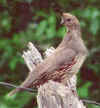|
|
Description:
The Gambels Quail is a well known species in aviculture and in the wild. Also known as the Arizona, top-knot or desert quail, they are found in arid areas of the southwestern United States and parts of Mexico.
This species is often confused with the related, Valley Quail. Males of both species share the black top-knot plume. Male Gambels can be distinguished by having no scaling on the lower breast, but rather having a yellowish belly with a large black spot. The top of the head is rusty brown with a white border and a black face, forehead and chin; the back and upper breast is grayish brown with rusty brown flanks that have white streaks. Females also have a top-knot, but it is much smaller in size. Her overall coloration is similar to the male, but she lacks the black and white face, the black breast spot and the rust color on her is much lighter. The hen is also slightly smaller than the male.
In the wild, Gambels Quail form large groups or coveys. Flocks as large as 200 during the winter, have been reported in Arizona! During the spring, these large flocks break up and the males begin to draw females to their chosen territory. Fights between rival males can become quite vicious while they try to draw mates into their territories.
|
|
Breeding:
This species is a prolific layer in captivity and clutch sizes are quite large. Here in Iowa, I noticed that do not start laying until mid-May, but I'm sure it is much earlier in warmer climates. In the wild, the female does the incubating which lasts about 23 days. The male often stands close-by and helps with the brooding. I've yet to have a Gambles hen go broody in captivity, but they hatch well and the tiny chicks are easy to raise. They do grow fast, flying at about three weeks of age!
|
|
General Comments:
This species is real joy to have in your aviary. They are very active and nervous, therefore require a larger pen than most quail. We keep our Gambels on the ground, bedded with straw. Our cages include many branches for perching and a pan of sand for a dust bath.
Gambels can be quite aggressive when adding new birds to an existing flock during the breeding season. If you must add a new bird, do so during the winter when they form coveys. It is also a good idea to keep many birds together during the cold months, this way they will naturally form a covey for warmth.
|
|
Place Mouse over Pictures to Enlarge

Gambel
Quail Male

Gambel
Quail Male

Gambel Quail Hen and her family

Gambel Quail Cubby
More Pictures
|